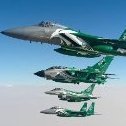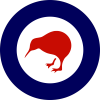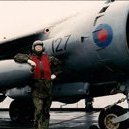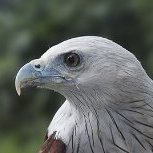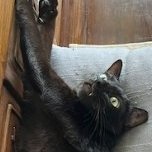Search the Community
Showing results for tags 'hawk'.
-
Bought for the princely sum of €15 in the Dublin Model Shop. Scalemates says 1991. Sprues a weird mix of flash and very fine moldings, very nice panel line detail. Gotta love that cockpit detailing 😃 Not sure which scheme the kit has a blue navy scheme and red civilian scheme that requires some modifications to an F8F-1 which is detailed in the instructions but I’m leaning towards the -1 atm.
- 15 replies
-
- 10
-

-
Curtiss H-75 A1/A2 (70080) 1:72 Arma Hobby The Model 75 or Hawk as it was more commonly known outside the Curtiss company was one of the first of a new generation of all-metal monoplane designs that reached production around the same time as the other major combatants that saw service at the beginning of WWII. It was of a similarly advanced design, benefitting from retractable landing gear, and enclosed cockpit, with a close-fitting cowling around the Pratt & Whitney R1830 radial engine that was used for production variants. It first flew in 1935 using an earlier engine, and it mounted just one machine gun that fired through the arc of the propeller, without any of the features found in later combat-capable variants, such as seat armour and self-sealing fuel tanks. To improve rearward-vision of the pilot, scalloped windows were added behind the canopy glazing, which was a feature that was carried forward to the later P-40 that eventually replaced it. It won a fly-off against a competing design from Seversky, and a small order of production airframes was made after the engine had been replaced by the R1830 that would eventually be used in production, offering a moderate boost in power and top-speed. It was a diminutive airframe that had a low wing-loading, giving it excellent manoeuvrability and a rapid rate of climb for the era, although its performance dropped off at higher altitudes due to the single-speed supercharger. As the clouds of war gathered, France tried to remedy their capability shortfall by making first one order of 100 airframes, followed closely by another tranche of 100, some of which fought valiantly against the Nazis during the invasion of France, unsuccessfully staving off the enemy forces. Another order was made, although this was slowed appreciably by US opposition because deliveries to overseas buyers were seen as slowing their own deliveries. Given that the US wasn’t actively engaged in the war at this point, President Roosevelt intervened to assist, as the French-made alternatives were suffering from delays due to engineering problems, leaving them short. Many French pilots flew their aircraft to Great Britain once it became clear that the Battle of France was lost, and joined other aircraft that were shipped away from the combat zone before the Armistice to avoid them falling into enemy hands. There were eventually just under 230 airframes in the UK, receiving the name Mohawk Mk.I-IV, corresponding with their original designation A1-4. These airframes were distributed around the Commonwealth to free up first-line aircraft for defence of the realm, as although the Mohawk out-performed the early Mk.I Spitfires in some aspects, the Supermarine design was overall superior when handled by experienced pilots. Germany sold captured H-75s to Finland in three batches, including a small number of airframes captured during the fall of Norway. They were well-liked by the Finns, and served until after WWII, often with upgraded armament to replace their rifle-calibre machine guns to cope with more heavily protected armour they flew against, as well as making ammunition replenishment more straight forward. In American hands the P-36 played little active part in WWII, only flying against the Japanese at Pearl Harbour where they scored some of the first kills of their war, although technically war had yet to be declared by the US. The Kit This is a brand-new tooling from Arma Hobby of this American fighter, arriving in an end-opening box with a painting of a French H-75 flying over broken cloud, with profile artwork of the three decal options on the rear. Inside the box are two sprues of grey styrene, a separately bagged sprue of clear parts, a sheet of pre-cut yellow kabuki-style tape masks, and the A5 portrait instruction booklet that is printed on glossy paper in colour, with three pages at the rear devoted to a full set of profiles for the decal options. The front cover has a short history of the H-75 at the top in Polish and English, with a sprue diagram in the middle, and a colour chart at the bottom of the page, giving colours for Hataka, AK RealColor, Mr Color, Ammo, Humbrol, Mr Paint, and Tamiya, plus colour names and FS numbers where applicable, which will be pointed out through the steps in blue circled letter codes. Detail is excellent, with finely engraved panel lines, raised and recessed features, plus plenty of detail in the cockpit, gear bays and a full rendition of both piston banks of the engine. The instructions also include a QR code that leads to a link where a 3D .STL file can be downloaded to print out additional parts if you have access to a 3D printer, which will add to the already impressive detail present in the box. We understand that those who don’t have access to a printer can purchase the parts at the same time as the kit, so they aren’t left out. Construction begins with an unusual process for a styrene kit, involving folding up the long spar-like parts along thinned lines into a hollow box, gluing the ends together, unless you intend to depict the domed fabric liners that were sometimes fitted instead. Your choice of bay liner is glued into the lower wing, and if you are omitting the fabric liners, you will need to paint the ribbed detail that is moulded into the underside of the upper wing half, which is full-span, just like the lower. The two halves are glued together, painting the centre the same colours as the cockpit, with metal scuff panels, adding the control column, its linkage, throttle body and a lever to the floor, plus extra parts to the already detailed cockpit sidewalls that are moulded into the fuselage sides. Detailed colour and decaling instructions are present in nearby scrap diagrams to help you complete the task, and this extends to the seat, which is fixed to the armoured frame with headrest. The instrument panel has the rudder pedals moulded into the back, and there are an additional four decals included to supply the details of the dials and other equipment, fixing it and the seat into location points in the port fuselage side before closing the two halves together, noting that one decal options has a series of vents in the side filled, as they weren't present. The fuselage and wings are mated, taking care of the controls as you bring them together to avoid damage to them. Once the fuselage and wings are firmly fixed and the seams have been dealt with, the nose is extended by adding two parts to the front, which has a peg in the centre to support the engine once it has been built and painted. The entire tail is separate from the fuselage, starting with the elevator fins, which slot into place in the rear, adding the tail fin to another slot, and completing the empennage by mounting a single-part elevator to the rear, trapping it in place with the rudder, which interlocks near the bottom. The Twin Wasp engine is supplied as a two-part assembly that depicts both banks of cylinders, adding a bell-housing with push-rods to the front, then mounting it onto the peg at the front of the fuselage after painting, wiring up the cylinders if you’re feeling the urge. The bottom segment of the engine cowling is attached under the nose, joined by two side cowling panels that have cooling gills moulded-in, and are joined by the top cowling after inserting gun muzzles into the ‘frog eyes’ moulded into the top. There was a simplified variant of the Hawk with fixed, spatted landing gear, but the majority had retractable gear, which is the variant depicted here. Each gear leg has a complex captive bay door fitted behind the two-part wheels, and another pair of doors fixed to the ‘knee’ joints at the tops of the legs, one on each side with twin retraction jacks shown in scrap diagrams across the page, handed as appropriate. The tail wheel has its yoke moulded-in, and two bay doors to the sides, adding a pair of exhausts and their fairing under the nose, and an intake under the engine. A clear landing light pushes into a recess under the port wing, and for two decal options the rows of five pins that presumably fed a pack of underwing rockets are removed and the area made good by smoothing it with successive grades of abrasive. Righting the model allows fitment of the filler cap in the port rear-view scalloped window, with a corresponding hole drilled in the clear part, and an aerial mast on the spine between them. The three-bladed prop with separate spinner is inserted into the bell-housing of the engine, and another pair of gun barrels are slid into holes in the leading edges of the wings. The last job is to fit the gunsight in the front of the cockpit, followed by the windscreen, canopy, and the two rear-view windows behind. The final diagram shows the location of the antenna wires between the wingtips and tail-fin, with a fly-lead that enters the fuselage on the starboard side just behind the rear-view window. Self-Print 3D Parts A QR code at the front of the instruction booklet offers the potential of printing your own aftermarket parts for this kit, although that’s either dependent upon you having a printer, a friend with a printer, or remembering to buy a pre-printed set when you’re picking up the model. We’ve been provided with a set of parts as an example, and must stress that the parts aren’t included with the standard kit. The 3D .STL file will output a print-base that includes the following: Bulkhead with Seat & Belts Instrument Panel with Rudder Pedals Exhaust Pipes with Fairings Gun Barrels (x4) Reflector gunsight Ring & Bead Back-Up Sight (x4) If you’re wondering why there would be four of some items, it’s because they are very delicate, and may get damaged, or possibly fail to print in some circumstances. The detail is well worth the effort though, and the parts are protected by a set of stout legs in the corners of the print base, which should be proof against most minor impacts or clumsiness. Markings There are three decal options on the sheet, each in substantially different schemes, which should widen the appeal for those intending to use kit decals. From the box you can build one of the following: Curtiss H-75 A2 No.107 (U007), GC 1/55, Pilot 1st Lt. Jan Zumbach, Bordeaux, June 1940 Curtiss H-75 A1 No.16 (U015), 1. Escadrille GC I/5, Pilot Sgt. Léon Vuillemain, Reims, Spring 1939 Curtiss H-75 A1 No.35 (X834), 3. Escadrille GC II/5 ‘La Fayette’, Pilot Adj. Marcel Dougoujon, Toul-Croix-de Metz, November 1939 Decals are by Techmod, which is a guarantee of good registration, sharpness and colour density, with a thin gloss carrier film cut close to the printed areas. The masks are cut from paper-based kabuki tape, and include individual masks for each of the canopy panels, the wheels, and the landing lights. Peeling them and applying them with a tweezer should make painting the clear parts a breeze. Conclusion A modern tooling of this once leading-edge fighter that was quickly left behind due to the increase in technological pace that accompanies warfare. Detail is excellent, as are the masks, the optional self-printed upgrade parts, and the decal sheet. Highly recommended. Review sample courtesy of
-
V.P.
- 52 replies
-
- 18
-

-

-
Afternoon all. I'd like to join the fun please. This is my chosen victim, I mean subject. I did remove the the main airframe components from their runners last night, mainly due to Revell's shipbuilding-style gates. I'm at work at the mo but home time is approaching. I think The Great Escape method is the one for me so we'll see how it goes. I can't live with the kits early rear end in later markings so Xtradecals or Modeldecals will probably come to the rescue for a wraparound camo TWU machine with early bang seats from a 70s Airfix Hawk. Phil
-
My first RFI upload in over a year! Been busy with University stuff so not as much workbench time, working on many projects though and just finished this one. Overall the kit wasn't a huge nightmare, some faults here and there, the ejection seats are the wrong variant, I couldn't get aftermarkets so that's a mistake I made, I also messed up the canopy which bothers me but apart from that I'm happy with how it turned out. Because of bad weather I can't take decent photographs right now so this will have to suffice. Another added to the RAF Camo collection! I am unsure what is next on the workbench, but I'll try to post better photos of the hawk later. Thanks for looking!
-
Clear Prop Models is to release 1/48th (expected later in 1/72nd too) Curtiss H-75/P-36 Hawk kits. Source: https://www.facebook.com/Clearpropmodels/photos/a.2307674699515016/2936223003326846 Box art - FMA-Curtiss Hawk 750 V.P.
- 49 replies
-
- 13
-

-

-
After the 1/48th kits, Clear Prop Models is to release 1/72nd Curtiss H-75/P-36 Hawk kits. Source: https://www.facebook.com/Clearpropmodels/photos/pcb.3078250142457464/3078248242457654 First boxing - ref. CP72021 - Curtiss H-750 Hawk Box art V.P.
- 19 replies
-
- 11
-

-

-
- Hawk
- Clear Prop Models
-
(and 1 more)
Tagged with:
-
Thought I'd pop my placeholder down for my build. In a departure from my usual RAF WW2 Builds - I'm going to build this 1/48 Hobbyboss Kit as a Royal Canadian Air Force BAe CT-155 Hawk Training aircraft which is part of the NFTC (Nato Flying Training in Canada) at CFB Cold Lake & CFB Moose Jaw Here's the obligatory sprue shots 🙂 Not included in the photos are Montex Canopy Masks, Flying Leathernecks Miniature Detonation Cord, Reskit MB Mk.10LH Ejection Seats and Flightpath ASCI Pod with AIM-9L Sidewinder Looking forwards to this one 🙂 Many regards Matt
- 12 replies
-
- 12
-

-
Dekls saudi hawk made using the revell 1/72 red arrows kit. The decals were difficult to apply as they required 2 layers to get the colours right and cutting around the fins on the wing but they look OK now. Paint used is revell emerald green
-
Hi All, We have a wee while to go so I'll share this gem from the bottom of the stash which will be my contribution to the Group Build. I bought it 2nd hand but suspect its been through a few sets of hands on its way to me. The box was part opened on one end but I opened the sealed plastic bag this morning. There are no dates in the kit but it has HAWK scribed into the stbd fuselage half in the usual rough manner. Scalemates lists it as released by Hawk in 1946 and this Testors boxing is from 2009. The moulds are ancient but my kit is not too old. I'm it will fit perfactly! I'll run this as a second build for now while finising a few entries in the 'Baby Boomers' Remember the A3 double sided instructions? Colin
- 23 replies
-
- 19
-

-
AZmodel is to release a new tool 1/72nd Curtiss P-36 Hawk kit - ref. Source: http://www.britmodeller.com/forums/index.php?/topic/234931186-azmodellegatoadmiral-wwii-aircraft-comments-questions-and-wishes/?p=2480480 V.P.
-
Graf Zeppelin 1:245 Hawk/Lindberg The design and construction of Graf Zeppelin were essentially conservative, based on tried-and-true technology developed over the Zeppelin Company’s decades of experience, and the ship was constructed of triangular Duralumin girders, with frames spaced 15 meters apart. The design of the Zeppelin was constricted by the size of the building shed at Friedrichshafen, which had inner dimensions of 787 feet in length and 115 feet in height. Since greater size meant greater efficiency in long distance operation, the challenge for Ludwig Durr and his design team was to create a ship with the largest possible gas capacity that could be built within the confines of the construction shed. Thus the airship that was designed was a cylinder 776ft in length and 100ft in diameter. The gondola, which was slung under the nose of the airship meant that the height of the airship from the bottom of the gondola to the top of the hull was 110ft. Whilst not the most aerodynamically efficient design it did incorporate one interesting feature, in the fuel used for powering the five Maybach VL-2 12-cylinder engines, which could develop 550hp at maximum revolutions, and 450 hp at 1400 RPM in cruise. This was the use of Blau Gas which had the same density as air so wouldn't upset the balance of the airship as the fuel was used, unlike more conventional fuels such as paraffin and diesel. This also gave the airship an extra 30 hours of flying time as the lifting Hydrogen gas didn't need to be expelled to keep the airship at the correct altitude. The use of Blau gas allowed the Graf Zeppelin to stay aloft for over 100 hours. The Graf Zeppelin had a career spanning nine years, and in that time made 590 flights and carried over 34,000 passengers without incident. She also carried out the first commercial and scheduled flights across the Atlantic, first around the world and even flew a scientific mission over the North Pole. Graf Zeppelin was over the Canary Islands on the last day of a South American flight from Brazil to Germany when it received news of the Hindenburg disaster in Lakehurst, New Jersey. Captain Hans von Schiller withheld the news from his passengers, and told them of the disaster only after the ship’s safe landing in Germany. Graf Zeppelin landed in Friedrichshafen on May 8, 1937, and never carried a paying passenger again. The ship made only one additional flight, on June 18, 1937, from Friedrichshafen to Frankfurt, where she remained on display — all her hydrogen removed — until she was broken up on the orders of Hermann Goering’s Luftwaffe in March, 1940, bringing to an end the era that these huge and graceful ships of the sky brought about. The Model The kit arrives in a very long and quite deep box with several pictures of the Graf Zeppelin on the front and sides. Even though it measures out at 38.5" or 97.8cm long there are very few parts, the two hull halves and a single sprue of quite hard white styrene, one sprue of nylon, apparently. There is also a single clear styrene part and a sealed bag for the included lighting equipment. Detail is naturally quite sparse by the very nature of the airship. The longerons of the hull and fins are quite prominent, perhaps a little over emphasised, but should look ok given a slight sanding down and under a coat of primer and Alclad or similar, in fact the kit is so big it might be better just to go to Halfords and get various shades of silver auto paint. There were apparently shape issues with the older kit and even though it says new tooling on the box there really isn't any evidence of this, so the incorrect cross-section is still there. The nylon parts are also pretty awful to work with whether gluing or filling so beware. Construction is very simple, much like the instructions which leave a lot to be desired. The hull halves have very large location pins and holes and they do give a very positive fit, (not shown in the photograph above, as I wanted to get it apart again), although it will still need some careful gluing and an extensive seam removal session. There is a small conical nose piece that's fitted to the bow. The four tail fins are each made of two halves and locate well into their slots. Again the longerons may need sanding down a bit. Unfortunately the balance horns, on the nylon sprue are completely the wrong shape, rather than being teardrop they should be and aerofoil shape. There are pictures of these on the interweb amongst many others than would prove useful for this build, or at least show up how many other problems there are in the kit. The engines and propellers are also moulded in nylon and as mentioned above are a real problem in assembling, filling and painting. Hawk probably thought it better to use nylon as it is stronger than styrene and as the pods stick out there is a likelihood of breakage. It would have been preferred if they were standard styrene and take the risk to be honest. The struts could always be replaced with brass rod instead. Brass rod will also be required for the fin bracing wires. Anyway the engine pods are in two halves and the propeller shaft is sandwiched between them. There are five in all, two on each side and the fifth on the centreline aft. They will also need bracing wire to complete. The main gondola is a three piece item, the gondola, a clear insert, which is actually very clear, and the gondola bottom. Into the gondola are the pilots controls station and a number of comfy chairs. It also houses the lighting cct. lights, switch, and 3v coin cell battery all included. The internals all fitted, painted and in the case of the lights, tested, the gondola is fitted into place. There is a small bumper parts that is then added to the underside. There are one of the girders, framework and other fittings that are visible in the real Graf Zeppelin in the gondola which is shame, but some enterprising modeller should be able to scratch build this if they like. The rest, as they say is up to the painting and getting the various shades of silver dope that is very noticeable on the real thing, not forgetting that this is a BIG kit. Decals The decal sheet contains the main name titles for the front hull, and registration numbers for the hull just above the rear engine pods on either side and on the upper fin. They are high density and the carrier film looks reasonably thin so should settle down well. It's a shame that decals weren't included for the later years of operation under the Luftwaffe, but there are aftermarket sheets that can provide the swastikas and a bit of colour matching for the paint. At least this version would have added some much needed colour the completed model. Conclusion This is certainly and interesting and impressive kit, if purely for its size. The hull problems cannot be easily sorted, but with the addition of some brass rod and strut it could be made into a good looking model and will look impressive, whether hung from the ceiling or or the stand provided, although a better one would be preferable. I can recommend it purely as something different, baring in mind the problems mentioned above. Review sample courtesy of
-
I am a new member of BritModeller forum. After joining I signed up for "Bomber/Strike/Ground Attack GB" that started on Sat, 22 Jan 22. For that GB I have chosen Airfix 1/48 Red Arrows Kit and thought of converting this as a IAF Hawk to be eligible for the GB. This was my second aircraft build and did a lot of mistakes during the build. I struggled a lot but could not complete it on time so I have dropped out of the first GB, I signed up with BM.... After I left this build half way, I selected few of Tamiya's Bf109 E3 and the Spitfire F Mk. IX just to learn. After messing up and learning during these builds, I picked up the Red Arrows kit again. Since I was no longer part of the GB, I decided to build it like one of the IAF Surya Kiran Aerobatic Team’s aircraft… I managed to complete the build last month and below are some of the pictures…. Printed decals at home so the quality is not great. Still learning…. Note - Landing gear door is fixed now.... And also few detail painting. Thanks for looking. Have a Great Day Mukund
- 13 replies
-
- 36
-

-
- Suryakiran
- Indian Air force
-
(and 1 more)
Tagged with:
-
Hi everyone, first time I posted in RFI. I am sharing my first 1/48 aircraft which I started in Sept and just managed to complete. To me, get it done is already a big win. There are lots of thing I learnt here while building mine, I made lots of mistake too. You can also refer to the WIP here.
-
I like trainer, I like 2-seater airplane, especially with a huge canopy but with a short tail. BAE Hawk T is exactly my cup of tea. Started with cockpit, spray a layer of GSI #1500 black primer as the base, and applied GSI 305 (dark grey) and GSI 306 (med grey). Decals was good and easy to apply. Applied a layer of gloss clear on the cockpit, #306 on the side wall of the cockpit and black on the inner wall of the air intake / exhaust. It is Modo T024 silver on the "engine" and MX-02 on the exhaust. I doubt if the engine can be seen after the build. Test fit the fuselage too - seems to be a nice match without any major gap.
-
This is HobbyBoss' 1/48 Hawk. Overall this was a very enjoyable kit to build and well engineered. This fit was good throughout and though I am definitely no Hawk expert, it looks right to me! I built the kit OOB and having seen the rather unusal ETPS scheme I was instantly made-up on what markings my hawk would be in! Painted with a mix of Tamiya Acrylics and Humbrol enamels, I weathered the model using oils and washes. Thanks for looking! Angelo
-
Wolfpack Design is to rebox in August 2021 the Academy 1/48th Curtiss P-36A Hawk "Pearl Harbour" - ref. WP14811 - as Premiun edition kit. Sources: http://www.wolfpack-d.com/catalog/htm/wp14811.html https://www.facebook.com/photo/?fbid=224202139513183&set=a.176768147589916 https://www.1999.co.jp/eng/10805644 Box art & more Curtiss P-36A Hawk 'Pearl Harbor' (Premium Edition Kit) Sprue parts by Academy Plastic models, Total over 60 plastic parts with 2 PE (Color printing & Brass) 2 A/C markings for the USAAF in Dec. 7 1941 Canopy Masking seal included, Decal printed in Cartograf, Italy A4 color printing manual included V.P.
- 9 replies
-
- 6
-

-
- Hawk
- Wolfpack Design
-
(and 1 more)
Tagged with:
-
Greetings friends, I've just bought a lovely little 1/72 Revell Red Arrows Hawk, the modern tooling from 2015, and I wonder if anyone has experience with the transfers/decals, specifically whether they are opaque enough not to turn pink over the red paintwork. I've learned from bitter experience never to trust light transfers over powerful, or dark surfaces. I used some 'museum quality' transfers once and they were basically transparent. If I know in advance I might consider painting as much of the white as I can. Any thoughts, or indeed if you know how they'll fare over the red I'd be very grateful, thank you.
-
Arrived yesterday from Boscombe Down the original and complete Hawker Hawk prototype. For anyone modelling an original Hawk a visit to the Boscombe Down Aviation Collection at Old Sarum Airfield is essential. You can get close and personal, take as many photos as you wish and sit in a Hawk cockpit section that sits next to the full size aircraft. 154 arrived yesterday, by air: slung under a Chinook for the hop from Boscombe Down to Old Sarum. She is the very first Hawk flown, she spent her life being used for test and evaluation work, spending the last 20 years at the Empire Test Pilots School. At the last major overhaul she was painted black and fitted with a late 900 series RR Adour engine. Over the years she accumulated 6000 flight hours, and last flew in December 2018. The engine has been returned to Rolls Royce for re-sale, the pyrotechnic parts have been removed but otherwise she is as last flown. www.boscombedownaviationcollection.co.uk Happy to arrange a walk round photo session if anyone wants to do it.
- 22 replies
-
- 10
-

-

-
BAE Systems Hawk 100 Series 1:72 Airfix The Hawk 100 is the next generation Hawk following on from the original Hawker Siddeley Hawk. The new hawk has more advanced avionics, the provisions for more weapons, all contained in a redesigned fuselage with a new wing. The Hawk 115 (CT-155) was ordered by the Royal Canadian Air Force, the Hawk 127 by the Royal Australian Air Force, and the Hawk 128 (or T.2) by the Royal Air Force. The Kit This is a re-issue of Airfix's 2008 new tool with extra parts to reflect the Hawk 100. The kit arrives on five sprues and a clear spure. Construction starts with the cockpit. The tub is one part into which the instrument panels fit and the one part seats. A bulkhead goes on the back followed by one at the front to which the nose gear leg attaches (leave this off if you are going to do the model wheels up). Two pilots are provided if you wish to put them in your model. The cockpit and exhaust can then be fitted into the fuselage and it closed up, Airfix advise adding 5 grams of nose weight. Now the fuselage is together the instrument coaming and HUD can be fitted along with both intakes. We now switch to the main wing There is a one part lower wing with left and right uppers, before they go together the modeller will need to open up the holes for the pylons. On tope two fences are fitted and underneath 3 flap tracks each side are fitted. The wing can now be joined to the fuselage, and the tailpanes added. On the fuselage the top insert can be fitted and then the canopies. At the rear of the fuselage the air brake can be fitted in either the closed or extended position, The main gear is also now made up and added along with the gear doors. If the model is to be built in flight then airfix provide a set of single part doors so the modeller does not have to fit all the multipart ones. For the underwing/wing-tip stores Airfix provide four sidewinders and two tanks. These can be made up and added as needed. To finish up the models a few aerials are also fitted along with the nose piot tube. Decals The sheet is from Cartograf so there will be no issues there, the sheet gives markings for three aircraft; No. 76 Sqn RAAF, Williamstown, NSW, Feb 2003. No. 419 Sqn RCAF, CFB Moose Jaw, 2016 (WWII Anv Scheme). No. 25(F) Sqn, No.4 Flying Training School, RAF, RAF Valley 2018. Conclusion Its great to see Airfix now offering the latest version of the Hawk in 1/72. Highly recommended. Review sample courtesy of
-
NHS Charities Together Hawk 1:72 Airfix A73100 When the RAF began the search for a new fast jet trainer to replace the Folland Gnat, it was originally intended that the role would be fulfilled by the SEPECAT Jaguar. However, the advanced capabilities demanded of the new Anglo-French aircraft meant that it became too complex for use as a trainer As a result, Hawker Siddley Aviation began work on a private venture known as the P.1182. The design team produced a relatively simple, subsonic aircraft with a number of clever features. The fuselage is designed around a large, tandem cockpit, which features a significant difference in height between the student & instructor. This affords the instructor a much better view than in the Gnat. The wings featured double-slotted flaps which gives the Hawk excellent low-speed handling characteristics. Though the box calls this a BAe Hawk lets not forget it was a Hawker Siddley design. The first of the 176 Hawks ordered by the RAF entered service in 1976, designated the Hawk T.1. 88 T.1s were modified to T.1A standard, which allowed them to carry two AIM-9 Sidewinder missiles for use in the emergency air defence role. The Hawks reputation as an excellent aeroplane has been confirmed by the considerable success it has enjoyed in the export market. Users include the air forces of Australia, Canada, Finland, Indonesia, Saudi Arabia and the United Arab Emirates amongst others. A highly modified carrier capable version is in service with the United States Navy, where it is known as the T-45 Goshawk. The most famous role occupied by the Hawk, however, is as the mount of the world-renowned Royal Air Force Aerobatic Team the Red Arrows. The Kit This is Airfix's new tool kit from 2008 which we have not seen so far on BM surprisingly. For the Covid crisis in order to raise money for NHS charities Airfix ran a competition to design a scheme for the Hawk. The kit arrives on 3 sprues of grey plastic and a clear sprue. In line with the usual model building clichés, construction starts with the cockpit. This prominent feature is made up of a large tandem tub, instrument panels and coamings, control columns and bulkheads. The single part ejection seats look ok, both in terms of detail and shape for this scale, only one pilot is provided probably as a hang over from the kits previous life as a Red Arrow. Decals are also provided for the instrument panels. The rear bulkhead is added along with the front one, if building with the gear down then the nose wheel leg attached to the front cockpit bulkhead. After fitting the exhaust t eh main fuselage can be closed up around the cockpit. Airfix recommend fitting 5g of nose weight. The intakes are fitted to the sides of the completed fuselage before moving onto the wings. There is a single man lower wing with left & right uppers to be added. To the underside are fitted the flap actuators. The completed wing assembly can be fitted to the fuselage. Following this the tail planes, upper fuselage insert, canopy and front pitot tube are added. To finish off the large rear ventral airbrake is added complete with the strakes either side of it. If doing the gear down the rest of the landing gear and gear bay doors can be added. As with other recent kits Airfix provide separate doors for a gear up option. Markings A decal sheet from Cartograf provides markings for two aircraft. A. Winning Competition Design by Geoff Elliot b. Airfix NHS Desgin. Conclusion A good idea by Airfix in the middle of the Covid crisis, and a good idea to raise money for the NHS. Even if you want to build a regular Hawk from this boxing you can still feel good about getting the kit. Review sample courtesy of
-
RAF Red Arrows Hawk Small Starter Set 1:72 Airfix A55002 It is hard to think of a more Iconic Aircraft to represent the Royal Air Force than the famous Hawker Siddeley Hawk used by the Red Arrows Aerobatic Team. Here in this starter set the Hawk only has 24 parts. Here at least Airfix are labelling this as a starter set and not a full kit There is nothing wrong with the quality of the parts, these all seem to be up to the standards of the new 1.72 Airfix kits I have seen lately. These kits are great in one respect they will act as a bridge between the click together Airfix kits, and full on model kits. They will assemble like kits, but the lower parts count and thought to the engineering will make it a lot easier for the younger modeller. I cant understand why Airfix are not making more of this aspect to encourage younger modellers into the hobby. Now a look at the kit in more detail. The Kit The hawk is the standard Mark 1 as used by the Reds. It should be noted that the plastic in this starter set is bright Red presumably so the younger modeller does not have to paint it. I have used the sprue shots here from the previous double boxing with the Spitfire as they are easier on the eye and the cameral lens! Here we start in the cockpit, two single part seats are fitted into the main tub and this is fitted into the fuselage, and this is closed up. All bulkheads and instrument panels are built in. Two pilot figures are supplied if the modeller wants to use them. A pair of two part intakes fit to the completed fuselage. At the rear the tail planes go one. The main wing is a single part upper which the lower parts fits to, this can then be attached to the fusleage. Single part nose and main gear doors are supplied if the modeller wants them closed. For the gear down simplified assemblies are included. The nose gear leg is moulded as one single part with the wheel. For the mains each leg is a single part with a wheel, and then there is a single part with the inner gear doors. The outers being moulded onto the leg. A single part canopy completes the model. If wanted the model can be mounted to the Hawk shaped stand included in the kit. Markings A small decal sheet from Cartograf provides markings for XX310 from the Red Arrows. There should be no issues with these. Conclusion This is a great set to bridge the gap between click together kits and models for the younger modeller. It a shame Airfix dont champion it as this. Review sample courtesy of
-
Supermarine Spitfire & RAF Red Arrows Hawk Gift Set 1:72 Airfix A50187 It is hard to think of two more Iconic Aircraft to represent the Royal Air Force than the famous Supermarine Spitfire, and the Hawker Siddeley Hawk used by the Red Arrows Aerobatic Team. Here Airfix have brought these two aircraft together in a "Best of British" boxing complete with paints, glue and paint brushes. The first thing to say about this boxing is that these kits are not full on model kits as you would expect looking at the box. These are simplified model kits. The Spitfire has only 26 parts including its display stand, and the Hawk 24. On seeing this boxing I must admit I was expecting two full sized model kits in the box. Apart from the parts count on the side of the box there is nothing at all which would lead the modeller to thinking otherwise, its only when you look at the contents that you get the idea they are not full kits. There is nothing wrong with the quality of the parts, these all seem to be up to the standards of the new 1.72 Airfix kits I have seen lately. These kits are great in one respect they will act as a bridge between the click together Airfix kits, and full on model kits. They will assemble like kits, but the lower parts count and thought to the engineering will make it a lot easier for the younger modeller. I cant understand why Airfix are not making more of this aspect to encourage younger modellers into the hobby. Now a look at the kits in more detail. Spitfire The variant included here is a Mark Vc in markings for Pilot Officer Antoni Glowacki of No, 303 Sqn Based at Northolt in 1942. The kit has 26 parts including the Spitfire shaped display stand if the modeler wants to use this. The model can be built with the undercarriage raised or lowered. First off the two fuselage halves can go together with the tail wheel being moulded onto the left half. At the front the mount for the prop goes on and then the engine cover complete with moulded in exhausts goes on. The wings can then go together with a single part lower and left/right uppers. The pilots seat fits into the wing and then this is joined to the fuselage. The tailplanes then go on. Under the wings the radiator and oil cooler are fitted. Single part raised gear, or two part lowered gear are then fitted. The centreline carb intake is fitted. The pilot figure can then go into the seat if you want to use him, following this the aerial mast and single part canopy are fitted. At the front the single part prop and spinner are fitted. If the aircraft is to be mounted on the stand now is the time to do it. Hawk The hawk is the standard Mark 1 as used by the Reds. Here we start in the cockpit, two single part seats are fitted into the main tub and this is fitted into the fuselage, and this is closed up. All bulkheads and instrument panels are built in. Two pilot figures are supplied if the modeller wants to use them. A pair of two part intakes fit to the completed fuselage. At the rear the tail planes go one. The main wing is a single part upper which the lower parts fits to, this can then be attached to the fusleage. Single part nose and main gear doors are supplied if the modeller wants them closed. For the gear down simplified assemblies are included. The nose gear leg is moulded as one single part with the wheel. For the mains each leg is a single part with a wheel, and then there is a single part with the inner gear doors. The outers being moulded onto the leg. A single part canopy completes the model. If wanted the model can be mounted to the Hawk shaped stand included in the kit. Markings A small decal sheet from Cartograf provides markings for XX310 from the Red Arrows and Spitfire Mk.Vc AB174 of No, 303 Sqn Based at Northolt in 1942. There shoud be no issues with these. Conclusion This is a great set to bridge the gap between click together kits and models for th younger modeller. It a shame Airfix dont champion it as this, and make that clear on the box. Review sample courtesy of
-
This was the first kit I got when looking to return to modelling (but not the first completed). As a result of this I made a unique proposition to myself...it comes with paints and brushes...so I would only complete it with what came in the kit. The exceptions to this was I bought spray gloss (Humbrol), Clearfix, and Decalfix. I did this to try and save money, but also to review it more as a 'includes everything you need kit." It's something I thought about doing for a long time and finally did it! As usual you can see my full review over here. I actually started this before my Gnat which I finished in Yellowjacks (seen here). However, I didn't finish it until after. But I finished this afterwards because I ended up doing my Gnat in almost one sitting haha. The kits were pretty decent and I absolutely LOVE the stands. I really wish they'd include these style stands in more kits as I love making them gear up and ready to go sometimes - especially display schemes!

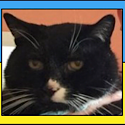


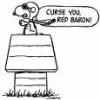



.thumb.jpg.a1642e430572922c3befa12f87efb548.jpg)
